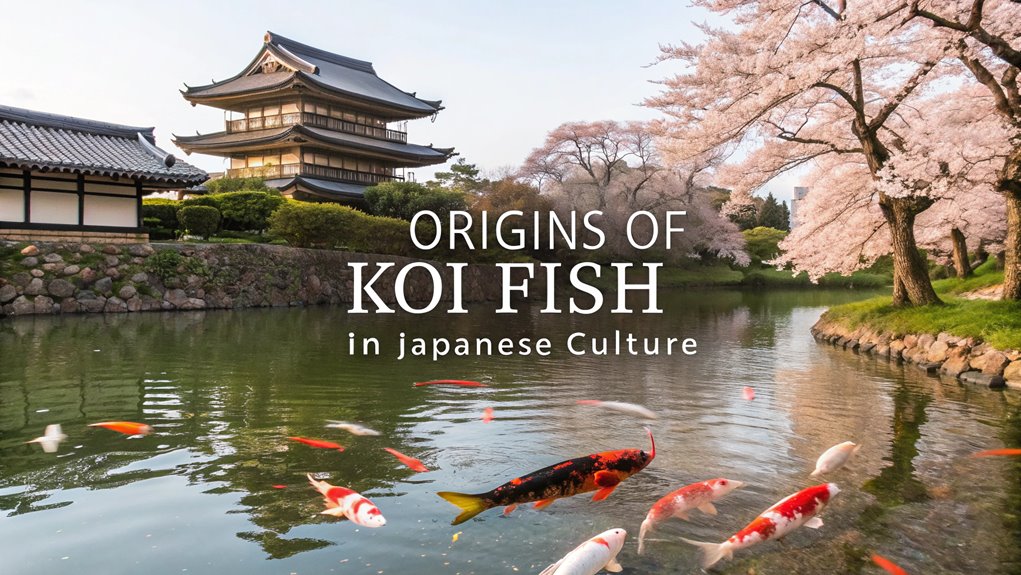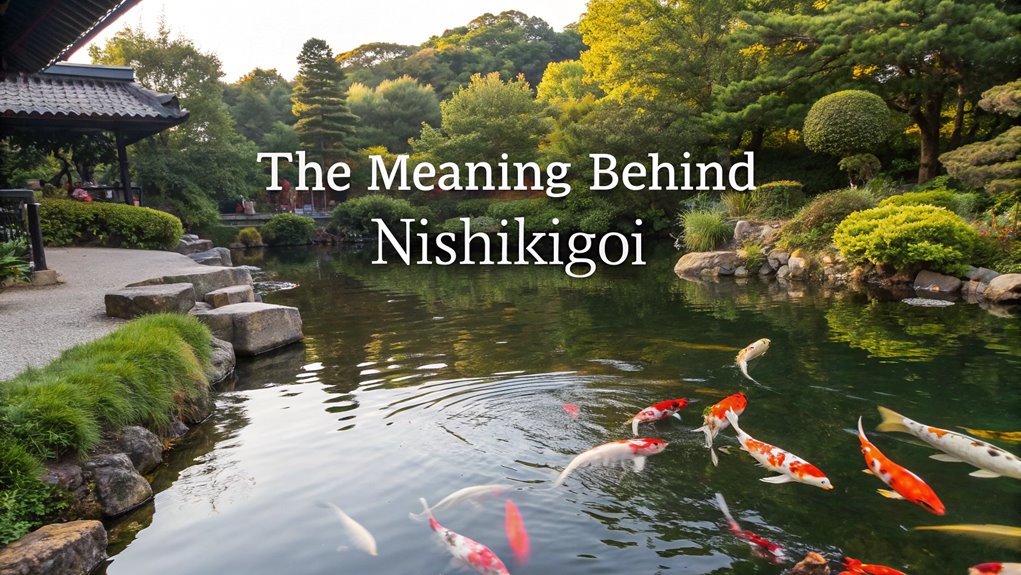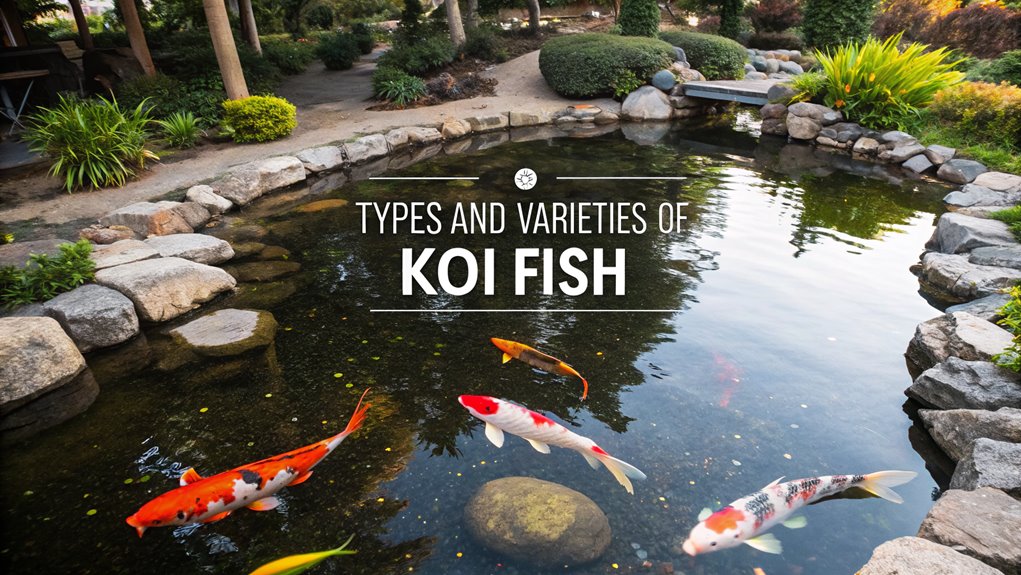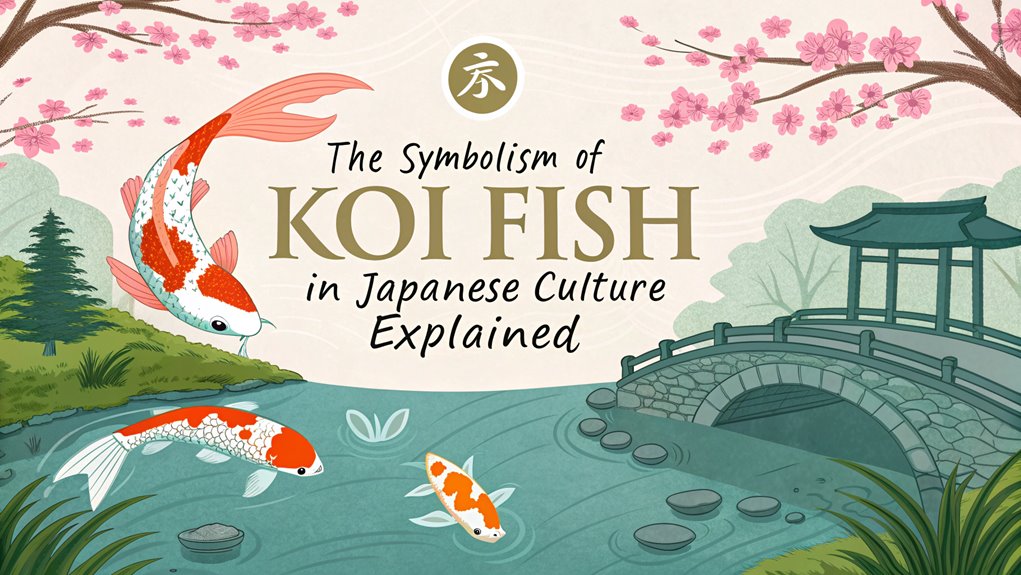In Japanese culture, koi fish symbolize perseverance and strength, mirroring a samurai’s resilience. They represent personal growth, embodied in the legend of koi ascending the Dragon Gate and transforming into dragons. Symbolizing prosperity and determination, koi appear prominently in festivals like Kodomo no Hi, celebrated through carp streamers. Each koi variety, such as Kohaku or Showa, holds distinct meanings. If you’d like, there’s much more to uncover about their rich cultural significance.
Key Facts Summarized
- Koi fish symbolize perseverance, strength, and triumph over adversity, reflecting the samurai spirit in Japanese culture.
- They are seen as emblems of ambition and personal growth, famously depicted in the Dragon Gate legend.
- Koi varieties like Kohaku and Sanke carry unique symbolic meanings, including purity, success, and resilience.
- Festivals like Kodomo no Hi use koi motifs to represent children’s aspirations and potential achievements.
- Koi fish in art and tattoos convey themes of good fortune, transformation, and enduring strength.
Origins of Koi Fish in Japanese Culture

While often admired for their beauty today, koi fish have deep roots in Japanese culture that go beyond their ornamental appeal.
Originally introduced to Japan as common carp in the 5th century BC for food, their transformation into ornamental varieties began with selective breeding in the early 19th century. This practice, originating in Niigata Prefecture, led to the creation of vibrant color variations collectively known as Nishikigoi.
Among these, the first distinct variety, Kohaku, emerged from natural mutations in Yamakoshi Village and Ojiya City.
During the Edo period, koi became symbols of nobility, with ownership reflecting wealth and status. Their cultural significance grew beyond Japan as international appreciation in the early 1900s solidified their status as global cultural icons.
The Meaning Behind Nishikigoi

The transformation of koi from common carp to vibrant Nishikigoi set the stage for their rich symbolism in Japanese culture.
Nishikigoi, or “brocaded carp,” draw their name from Japan’s exquisite “nishiki” fabric, reflecting their ornamental elegance. In Japanese culture, these fish embody bravery and resilience, akin to samurai, symbolizing the struggle and triumph over adversity, much like koi swimming against strong currents to become mythical dragons.
Originating 200 years ago in Niigata Prefecture, selective breeding produced over 100 stunning color patterns, enhancing their cultural significance.
Historically cherished by Japanese nobles for their beauty, Nishikigoi now represent prosperity and achievement, gracing gardens as living signs of success and ambition. Their presence inspires a sense of fulfillment and peace.
Types and Varieties of Koi Fish

Exploring the myriad types and varieties of koi fish reveals a rich tapestry of colors and meanings, each with its own unique significance in Japanese culture.
The Gosanke group stands out, featuring:
- Kohaku: White with red markings, symbolizing purity and success.
- Sanke: Kohaku with black spots, representing strength and resilience.
- Showa: Black base with red and white patterns, embodying transformation and balance.
Beyond Gosanke, you’ll find other fascinating koi varieties.
Bekko has black markings on differently colored bodies, adding depth to its symbolic meanings.
Meanwhile, Chagoi is recognized for its single color, symbolizing health and longevity. This variety is also known as the friendliest koi breed, enhancing the joy of interaction in koi ponds.
Selective breeding has led to over 200 color patterns, showcasing the artistry and cultural significance of koi fish in Japanese tradition.
The Legend of the Koi Fish and the Dragon Gate
As you delve into the legend of the koi fish and the Dragon Gate, you uncover a tale rich in symbolism and cultural significance.
The story describes koi swimming upstream in the Yellow River, facing fierce currents and predators. Only the most resilient and determined koi can ascend the Dragon Gate waterfall, symbolizing perseverance and the triumph over obstacles.
Upon reaching the summit, these koi transform into dragons, epitomizing ambition and the potential for personal growth.
This legend, deeply embedded in Japanese culture, is often shared with children as a motivational lesson, encouraging them to persist despite challenges.
The narrative also inspires cultural motifs, like the Pokémon Magikarp, paralleling the koi’s journey of transformation and resilience.
Symbolism of Koi Fish in Japanese Festivals
Koi fish, with their rich symbolism of perseverance and transformation, find a vibrant expression in Japanese festivals.
During Kodomo no Hi, celebrated on May 5th, koinobori (carp streamers) flutter in the breeze, symbolizing hope and determination for children’s future success.
These festivals showcase koi fish as symbols of strength and good fortune, deeply embedded in Japanese traditions. The Gion Festival in Kyoto features Koi Yama floats, reflecting the cultural significance of koi and their legendary transformation into dragons.
Their presence in festivals underscores several key aspects:
- Koi as a symbol of prosperity and perseverance.
- Cultural significance in Japanese celebrations.
- Artistic displays reinforcing their beauty.
- Parental aspirations for children’s success.
Koi fish continue to be prominent icons in Japanese cultural identity.
Koi Fish as a Symbol of Strength and Perseverance
In Japanese culture, when you delve into the symbolism of koi fish, you uncover narratives of strength and perseverance that are both profound and inspiring.
The legendary tale of koi swimming upstream to transform into dragons highlights their resilience and ability to overcome adversity. This journey symbolizes ambition and determination, embodying the Samurai spirit of bravery and success.
Their vibrant colors, like gold for wealth and red for success, further enhance their representation of personal growth.
On Children’s Day, koi streamers (koinobori) are flown, expressing hope and aspiration for children to grow strong and successful.
Koi Fish in Japanese Art and Tattoos
Japanese art thrives on symbolism, and the koi fish stands as a quintessential motif embodying perseverance and transformation. You’ll find koi motifs beautifully rendered in Ukiyo-e woodblock prints, where artists like Katsushika Hokusai capture the fish’s mythical journey to becoming a dragon.
This narrative of resilience and ambition is mirrored in koi tattoos, which often incorporate flowing water or lotus flowers to highlight overcoming adversity.
In koi tattoos, the colors and patterns carry profound meanings:
- Gold: Wealth and prosperity
- Red: Love and success
- Black: Strength in adversity
- Blue: Tranquility and peace
Koi motifs also appear in cultural products like koinobori and tenugui cloth, infusing daily life with artistic and cultural significance, celebrating both beauty and endurance.
Cultural and Economic Significance of Koi Fish
Beyond their artistic allure, these vibrant fish hold substantial cultural and economic weight in Japan. Originating from Niigata Prefecture in the 19th century, koi breeding transformed from a modest hobby into a significant economic activity. The ornamental fish’s aesthetic beauty elevated them as symbols of social status during the Edo period, reflecting wealth and nobility.
In contemporary times, koi competitions enhance their market value, with winning specimens commanding high prices and boosting breeders’ prestige. Their cultural significance extends to Japanese festivals, like Kodomo no Hi, where koinobori represent hope and perseverance.
Community celebrations often feature koi, underscoring their role in Japanese culture. Globally, their appeal as collectibles maintains their status as emblems of prosperity and cultural heritage.
Tips for Keeping Koi Fish as Pets
If you’re considering adding koi fish to your aquatic family, understanding their specific needs is crucial for creating a thriving environment.
Koi fish, with their vibrant colors and large size, are a stunning addition to any Japanese garden. To ensure their health and longevity, follow these essential tips:
- Koi Pond Size: Ensure at least 1,000 gallons of water per fish to accommodate their breeding and growth needs.
- Water Quality: Maintain a stable temperature between 59-77°F and ensure proper filtration and aeration to manage their high waste production.
- Feeding: Offer a diet of high-quality pellets and vegetables, adjusting frequency based on temperature to prevent overfeeding.
- Pond Design: Include deep and shallow areas with shade to protect koi from extreme weather and sunlight. Additionally, consider a balanced ecosystem that supports the overall health of your koi pond.
Frequently Asked Questions
What Do Koi Fish Represent in Japanese Culture?
You’ll find that koi fish in Japanese culture symbolize strength, perseverance, and triumph over challenges. They embody ambition and personal growth. Their vibrant colors convey specific meanings like wealth, love, and overcoming adversity, enriching their cultural and artistic significance.
What Is the Symbolic Meaning of a Koi Fish?
You might think koi fish are simply colorful pond dwellers, but they symbolize perseverance, strength, and transformation. Their vibrant colors represent wealth, love, and overcoming adversity, making them powerful symbols of personal growth and good fortune.
What Is the Japanese Saying About Koi Fish?
You’ll find Japanese sayings about koi emphasizing perseverance, transformation, and authenticity. Phrases like “Koi wa nagai tabi no saki ni” underscore the importance of resilience and reaching goals, while others highlight dreams and truth through koi’s journey.
What Does the Fish Symbol Mean in Japan?
In Japan, fish symbols, especially koi, signify strength and perseverance. You’re likely to find koi representing ambition and personal growth due to their legendary journey. Their association with prosperity also highlights Japan’s cultural emphasis on resilience.
Conclusion
As you gaze into the tranquil pond, imagine the koi fish, their vibrant scales shimmering beneath the dappled sunlight. These elegant creatures aren’t just ornamental; they’re woven deeply into Japan’s cultural tapestry. From their storied journey to the mythical Dragon Gate, they embody strength and perseverance. Whether adorning festival floats or inspiring intricate tattoos, koi fish symbolize resilience. By understanding their rich symbolism, you appreciate not just their beauty, but their profound cultural and economic significance.


